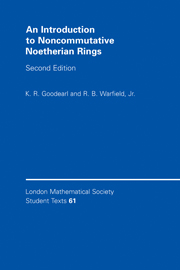Book contents
- Frontmatter
- Contents
- Introduction to the Second Edition
- Introduction to the First Edition
- Prologue
- 1 A Few Noetherian Rings
- 2 Skew Polynomial Rings
- 3 Prime Ideals
- 4 Semisimple Modules, Artinian Modules, and Torsionfree Modules
- 5 Injective Hulls
- 6 Semisimple Rings of Fractions
- 7 Modules over Semiprime Goldie Rings
- 8 Bimodules and Affiliated Prime Ideals
- 9 Fully Bounded Rings
- 10 Rings and Modules of Fractions
- 11 Artinian Quotient Rings
- 12 Links Between Prime Ideals
- 13 The Artin-Rees Property
- 14 Rings Satisfying the Second Layer Condition
- 15 Krull Dimension
- 16 Numbers of Generators of Modules
- 17 Transcendental Division Algebras
- Appendix. Some Test Problems for Noetherian Rings
- Bibliography
- Index
16 - Numbers of Generators of Modules
Published online by Cambridge University Press: 11 November 2010
- Frontmatter
- Contents
- Introduction to the Second Edition
- Introduction to the First Edition
- Prologue
- 1 A Few Noetherian Rings
- 2 Skew Polynomial Rings
- 3 Prime Ideals
- 4 Semisimple Modules, Artinian Modules, and Torsionfree Modules
- 5 Injective Hulls
- 6 Semisimple Rings of Fractions
- 7 Modules over Semiprime Goldie Rings
- 8 Bimodules and Affiliated Prime Ideals
- 9 Fully Bounded Rings
- 10 Rings and Modules of Fractions
- 11 Artinian Quotient Rings
- 12 Links Between Prime Ideals
- 13 The Artin-Rees Property
- 14 Rings Satisfying the Second Layer Condition
- 15 Krull Dimension
- 16 Numbers of Generators of Modules
- 17 Transcendental Division Algebras
- Appendix. Some Test Problems for Noetherian Rings
- Bibliography
- Index
Summary
We turn in this chapter to a very “classical” problem – estimating the minimum number of generators needed for a finitely generated module A over a noetherian ring R. In case R is commutative, there is a theorem of Forster from 1964 giving an estimate for the number of generators of A in terms of “local data,” namely, the values g(A, P) + K.dim(R/P), where P is any prime ideal of R and g(A, P) is the minimum number of generators of the localized module AP over the local ring RP. In the noncommutative case, we shall see that an appropriate analog of g(A, P) is the minimum number of generators needed for the tensor product of A with the Goldie quotient ring of R/P. With this adjustment, we shall derive an analog of Forster's theorem for finitely generated modules over any FBN ring.
In order to handle data from all prime ideals at once, it is most convenient to work topologically. Thus, we first develop an appropriate topology for the prime spectrum of R, and then we develop a continuity theorem for a normalized version of g(A, P) (considered as a function of P). In case R is FBN, this normalized function turns out to be locally constant, and the estimate for the number of generators of A can be obtained without too much further work.
Information
- Type
- Chapter
- Information
- An Introduction to Noncommutative Noetherian Rings , pp. 274 - 294Publisher: Cambridge University PressPrint publication year: 2004
